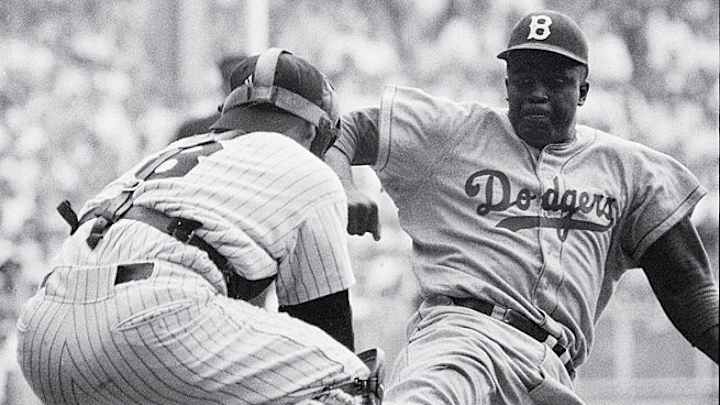On-field or off, Robinson's amazing performance still being felt


Forget for a moment the circumstances around Jackie Robinson's career. Forget what he was up against. Forget that he had played barely a season and a half of professional baseball when he broke in with the Brooklyn Dodgers in 1947, or that he was learning a new position (first base) or that, oh yes, he was bearing a societal weight unlike any borne by a major leaguer before or since. Forget all of that and let's look at the numbers. Let's look at how he played.
Robinson spent 10 seasons in the big leagues. (He was 28 when he debuted; his was not a mission that Dodgers' GM Branch Rickey could entrust to a very young man.) In five seasons he finished first, second or third in the National League in on-base percentage. Four times he was among the top four in batting average. In nine seasons Robinson finished among the league's top seven in stolen bases, twice leading the league. One of those years was 1949 when he batted .342, slugged .528 (third in the NL) and won the Most Valuable Player Award.
WAR stories? Three times Robinson led the National League in Wins Above Replacement. In another season he was second. In another he was fifth.
That rookie season when Robinson played first base only Hall of Famers Stan Musial and Johnny Mize had better batting averages at the position among National Leaguers. Robinson spent the next five seasons playing second. In three of those years he had the best fielding percentage of any second baseman in the league. In the other two he was second and third. Over that prime of his career Robinson was the best all-around second baseman in baseball and nobody else was even close. He ended his career with a .311 batting average, a .409 slugging percentage and an OPS of .883.
Whether he was yellow, black or striped like a zebra, as Leo Durocher might have said, Jackie Robinson was going into the Hall of Fame
The Dodgers averaged 96 wins and 58 losses over Robinson's career -- a winning percentage of .623. They played in five World Series. On a team that had Duke Snider, Roy Campanella and Pee Wee Reese, you can't say that Robinson was the only reason they won like that. But it is plain to see that they would not have been nearly what they were without him. "If it wasn't for him the Dodgers would be in the second division," Cardinals shortstop Red Schoendienst once said.
Jackie's play was even more valuable than what appeared on paper, in part because he lifted his teammates. ("What he did has got to be the most tremendous thing I've ever seen in sports," Reese once told author Roger Kahn.) Rickey knew what he wanted in the player he signed to break the color barrier: not a pitcher or a lumbering slugger but an infielder with the speed and sauce to impact every game. Although Robinson for the most part remained disciplined and restrained against the sharp indignities inflicted by a seething opposition, he never truckled and he played with a unique and daring style, with what folks in Brooklyn called chutzpah.
Robinson inspired legions of young black ballplayers, of course, a following symbolized in the new movie 42 by a character based on Ed Charles, who chased after Jackie when he saw him play in heavily segregated Florida during Dodgers' spring training, and who grew up to play third base on the 1969 Mets. ("He was talented and fancy," the real-life Charles has said, explaining Robinson's appeal.)
The inspiration, though, cut swiftly across lines of color and ethnicity. Robinson's combination of sheer athleticism and a dedication to the nuances of the game -- as a rookie he led the majors not just in stolen bases but also in sacrifice hits -- made him not simply a player whom fans admired, but one whom they sought to emulate.
"He was the most exciting and interesting player I have ever seen, and the one who made by far the biggest impression on me," says Ira Glasser, who grew up in Brooklyn mimicking Robinson's batting stance in stickball games and who credits Robinson for inspiring his choice of career: Glasser headed the American Civil Liberties Union from 1978-2001, expanding the group's moral center into an influential public force. Another white civil liberties figure (and Brooklynite) Norman Siegel, who led the NYCLU for 15 years, has prominently displayed in his home a drawing of number 42 sliding characteristically into home plate, spraying dirt with his fist raised?except that the face above the Dodgers' flannels is not Robinson's but Barack Obama's.
That's another thing that Robinson did: steal home. He did it 20 times, including, famously, in the 1955 World Series against the Yankees at age 37. Most of his attempts to steal home however occurred in the early years of his career, when he was establishing himself as a player who opposing teams always had to account for. From the beginning it was clear that Robinson needed to be judged not by the color of his skin but by the content of his game.
CORCORAN: Robinson was a legend as a player as well as a pioneer
JAFFE: Robinson resonates in Brooklyn and beyond
APSTEIN: A first-hand account of Robinson's rookie season
KENNEDY: Rachel Robinson reflects on life with her husband Jackie
SHEEHAN: Despite strengths, movie about Robinson falls flat
GRAHAM: A Q&A with Harrison Ford on portraying Branch Rickey in 42
